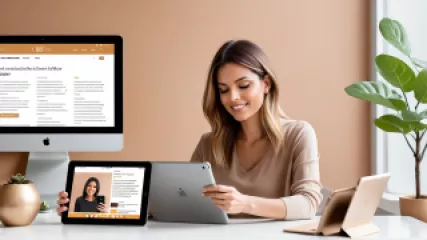My Journey with Cognitive Behavioral Therapy Apps for Better Mental Health
The Journey Begins: Embracing Cognitive Behavioral Therapy Apps for My Mental Health
As someone who has long struggled with the ups and downs of mental health, I've found myself on a winding path of self-discovery and healing. For years, I felt lost, unsure of how to manage the weight of my own thoughts and emotions. It wasn't until I stumbled upon the world of cognitive behavioral therapy (CBT) apps that I found a glimmer of hope, a way to take control of my mental well-being. This is the story of my journey with these digital tools, and how they've transformed my relationship with my own mind.
Seeking Solace in the Digital Realm
I still remember the day I first decided to seek help for my mental health struggles. It was a turning point, a moment of reckoning when I realized that I couldn't continue to live with the constant ebb and flow of anxiety, depression, and self-doubt. The idea of seeking in-person therapy was daunting, however, as I grappled with the stigma and accessibility challenges that so many people face.
That's when I discovered the world of mental health apps. In the digital realm, I found a space where I could explore different approaches to managing my mental health, all from the comfort of my own device. I spent countless hours scouring app stores, reading reviews, and trying out various offerings, from mindfulness apps to journaling tools and beyond.
Discovering the Power of Cognitive Behavioral Therapy Apps
It was during this digital exploration that I stumbled upon the realm of cognitive behavioral therapy (CBT) apps. As I delved deeper into the concept of CBT, I was intrigued by its fundamental premise: that our thoughts, emotions, and behaviors are all interconnected, and that by learning to identify and challenge maladaptive thought patterns, we can cultivate more positive and healthier ways of being.
The idea of having a digital coach to guide me through this process was incredibly appealing. I started experimenting with different CBT-based apps, each offering unique approaches and features. Some focused on building mindfulness and relaxation skills, while others provided structured exercises and lessons to help me reframe my thought processes.
Navigating the Landscape of Mental Health Apps
As I immersed myself in the world of mental health apps, I quickly realized that not all of them were created equal. Some were poorly designed, with confusing interfaces and limited functionality, while others seemed to offer genuine support and tools for personal growth.
I found myself carefully evaluating each app, assessing its features, user reviews, and overall effectiveness. I paid close attention to the app's approach to privacy and data security, ensuring that my personal information was being handled with the utmost care. It was a process of trial and error, but as I discovered the right apps for my needs, I began to see tangible improvements in my mental well-being.
Embracing the Power of Personalization
One of the most remarkable aspects of using CBT apps for my mental health was the ability to tailor the experience to my unique needs and preferences. Each app offered a slightly different approach, and I found that I responded better to certain techniques and features than others.
Some apps provided a more structured, lesson-based approach, guiding me through a series of exercises and activities designed to challenge my thought patterns and behaviors. Others offered a more freeform, open-ended experience, allowing me to explore different coping strategies and mindfulness practices at my own pace.
Ultimately, I found that the most effective apps were the ones that allowed me to take an active role in my own healing process, providing me with the tools and resources I needed to navigate my mental health journey on my own terms.
The Transformative Power of Consistent Practice
As I continued to use CBT apps as part of my mental health routine, I began to notice a profound shift in my overall well-being. The consistent practice of identifying and challenging negative thought patterns, coupled with the development of healthy coping mechanisms, had a cascading effect on my mood, behavior, and sense of self.
I found myself feeling more grounded, more resilient, and more capable of navigating the ups and downs of life. The lessons I learned through the apps didn't just stay within the confines of my device – they seeped into my everyday experiences, shaping the way I approached challenges and the way I interacted with the world around me.
The transformation wasn't always easy, and there were certainly moments of struggle and frustration along the way. But with each passing day, I could feel myself growing stronger, more self-aware, and more in control of my own mental health.
The Power of Community and Connection
One unexpected benefit of using CBT apps for my mental health was the sense of community and connection I found within the digital landscape. Many of the apps I used offered forums, chat rooms, and support groups where users could share their experiences, offer encouragement, and learn from one another.
Engaging with this online community was a revelatory experience. I realized that I was not alone in my struggles, and that there were countless others who were also on their own journeys of self-discovery and healing. The sense of camaraderie and understanding that I found within these digital spaces was truly invaluable, and it served as a powerful reminder that mental health is a universal human experience.
Through the connections I made and the stories I heard, I gained a deeper appreciation for the power of empathy, vulnerability, and shared experiences in the pursuit of better mental health.
Expanding My Mental Health Toolkit
As my journey with CBT apps progressed, I found myself expanding my mental health toolkit beyond just these digital tools. I began incorporating other complementary practices, such as meditation, exercise, and journaling, into my daily routine. This holistic approach allowed me to address my mental health from multiple angles, creating a more comprehensive and effective system of self-care.
I also started to explore the intersections between my physical and mental well-being, recognizing the profound impact that factors like sleep, nutrition, and stress management can have on our overall mental health. By addressing these areas in a more intentional way, I was able to further enhance the benefits I was experiencing from the CBT apps.
Navigating the Challenges and Setbacks
Of course, my journey with CBT apps wasn't without its challenges and setbacks. There were times when I felt overwhelmed by the sheer number of options available, unsure of which app or approach was the best fit for my needs. And there were also moments when I struggled to maintain the consistent practice required to truly see the benefits of these tools.
But even in the face of these obstacles, I found that the CBT apps provided me with a sense of structure and accountability that helped me stay on track. The in-app reminders, progress tracking, and personalized recommendations kept me motivated and engaged, even when the path ahead seemed daunting.
And when I did experience setbacks or periods of regression, the apps offered me a safe space to reflect, reassess, and recalibrate my approach. Through the lessons and exercises, I learned to be kinder and more compassionate with myself, acknowledging that mental health is a lifelong journey with ups and downs.
Embracing the Future with Renewed Hope
As I look back on my journey with CBT apps, I am filled with a deep sense of gratitude and wonder. These digital tools have not only transformed my own mental health but have also inspired me to share my story and advocate for the wider adoption of such technologies.
I've come to believe that the future of mental health care lies in the seamless integration of technology and evidence-based practices. CBT apps have the potential to reach individuals who may have limited access to traditional therapy, providing them with the resources and support they need to thrive. And as these technologies continue to evolve, I'm excited to see how they will further enhance and personalize the mental health experience.
My journey with CBT apps has been a profound one, filled with moments of self-discovery, growth, and empowerment. It has taught me that we all have the power to take control of our mental well-being, and that the right tools and resources can make all the difference in our pursuit of a healthier, happier life.
Embracing the Future with Renewed Hope
As I look to the future, I am filled with a renewed sense of hope and determination. The world of mental health apps is rapidly evolving, and I believe that the potential for these tools to transform lives is truly limitless.
I am excited to see how the latest advancements in areas like artificial intelligence, machine learning, and data analytics will further enhance the personalization and effectiveness of CBT apps. Imagine a future where these digital tools can adapt and evolve in real-time, providing us with tailored support and guidance that is truly responsive to our individual needs and experiences.
But beyond the technological advancements, I am also hopeful that the growing acceptance and normalization of mental health support will pave the way for even greater accessibility and inclusivity. As more people discover the power of CBT apps and other digital mental health resources, the stigma and barriers that have long hindered progress in this area will slowly but surely begin to erode.
And as this transformation takes place, I am committed to using my own experience and voice to advocate for the widespread adoption of these life-changing tools. It is my hope that by sharing my story and championing the benefits of CBT apps, I can inspire others to embark on their own journeys of mental health and wellness.
The road ahead may not always be easy, but with the powerful combination of technology, evidence-based practices, and a growing community of support, I believe that we can create a future where mental health is not just an afterthought, but a fundamental and celebrated aspect of our overall well-being.
Closing Thoughts: A New Era of Mental Health Empowerment
As I reflect on my journey with CBT apps, I am struck by the profound impact they have had on my life. These digital tools have not only helped me to better understand and manage my own mental health, but they have also opened my eyes to the transformative potential of technology in the realm of mental health care.
Through my experiences, I have learned that mental health is a deeply personal and complex journey, one that requires a multifaceted approach and the right tools and resources. But I have also discovered that with the right support and guidance, we all have the power to take control of our mental well-being and cultivate a healthier, more fulfilling way of being.
In the years to come, I believe that the integration of technology and evidence-based mental health practices will continue to revolutionize the way we approach this critical aspect of our overall health. And as more and more people discover the benefits of CBT apps and other digital mental health resources, I am hopeful that the stigma and barriers that have long hindered progress in this area will begin to crumble.
My journey with CBT apps has been a truly transformative one, and I am grateful for the opportunity to share my story with others. It is my sincere hope that by sharing my experiences, I can inspire others to take the first step towards embracing the power of technology in their own mental health journeys, and to join me in creating a future where mental health is celebrated, supported, and empowered in all its forms.






